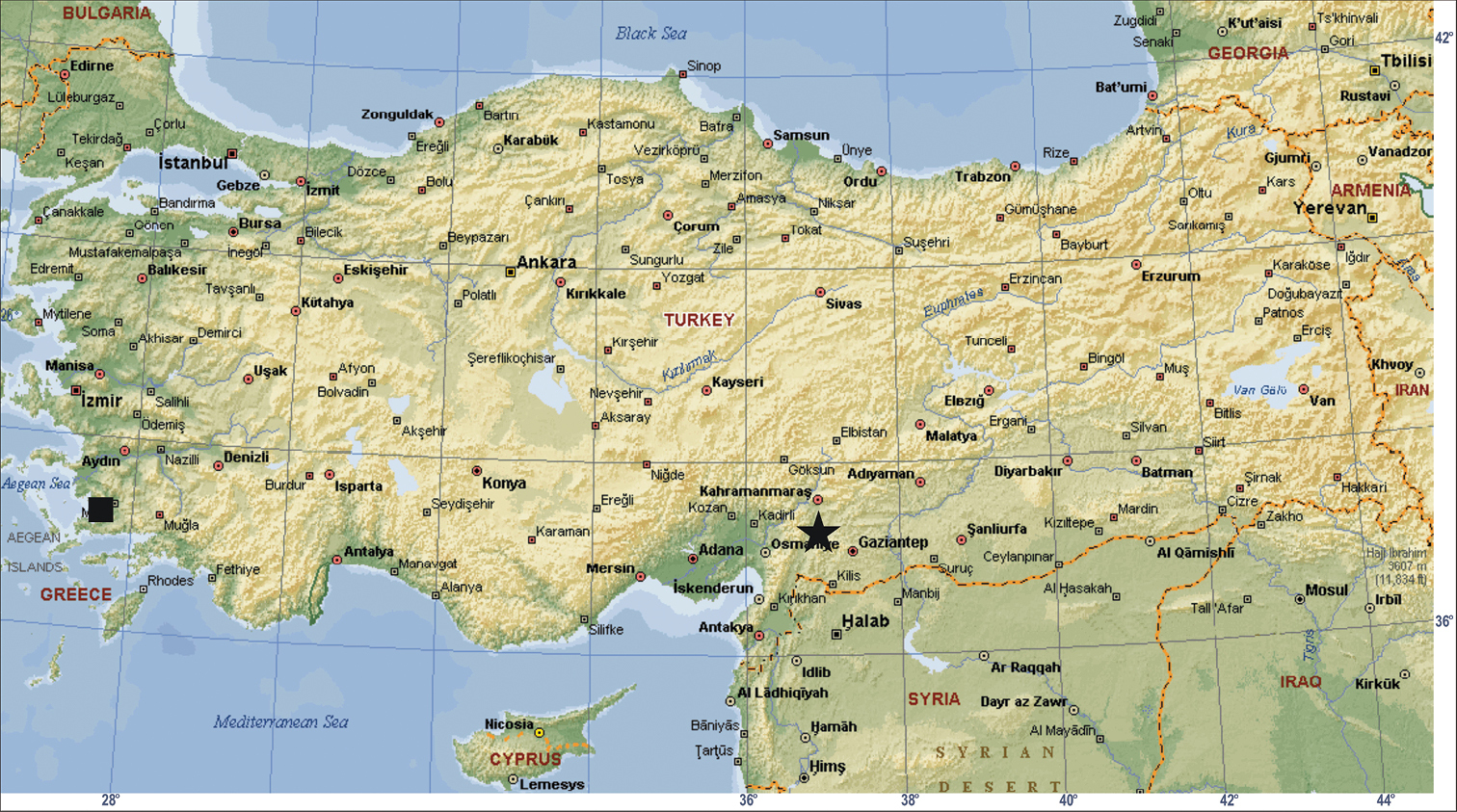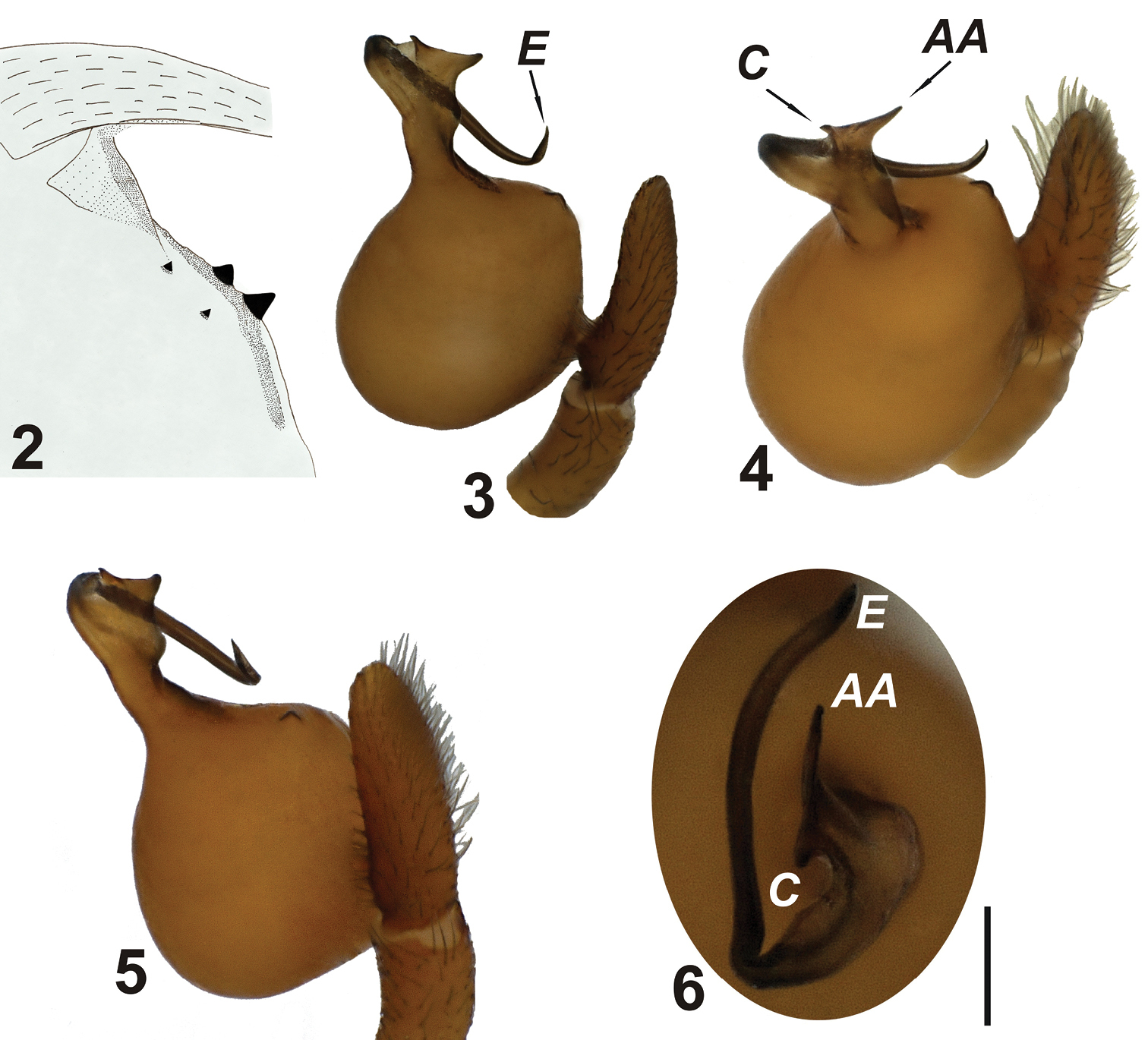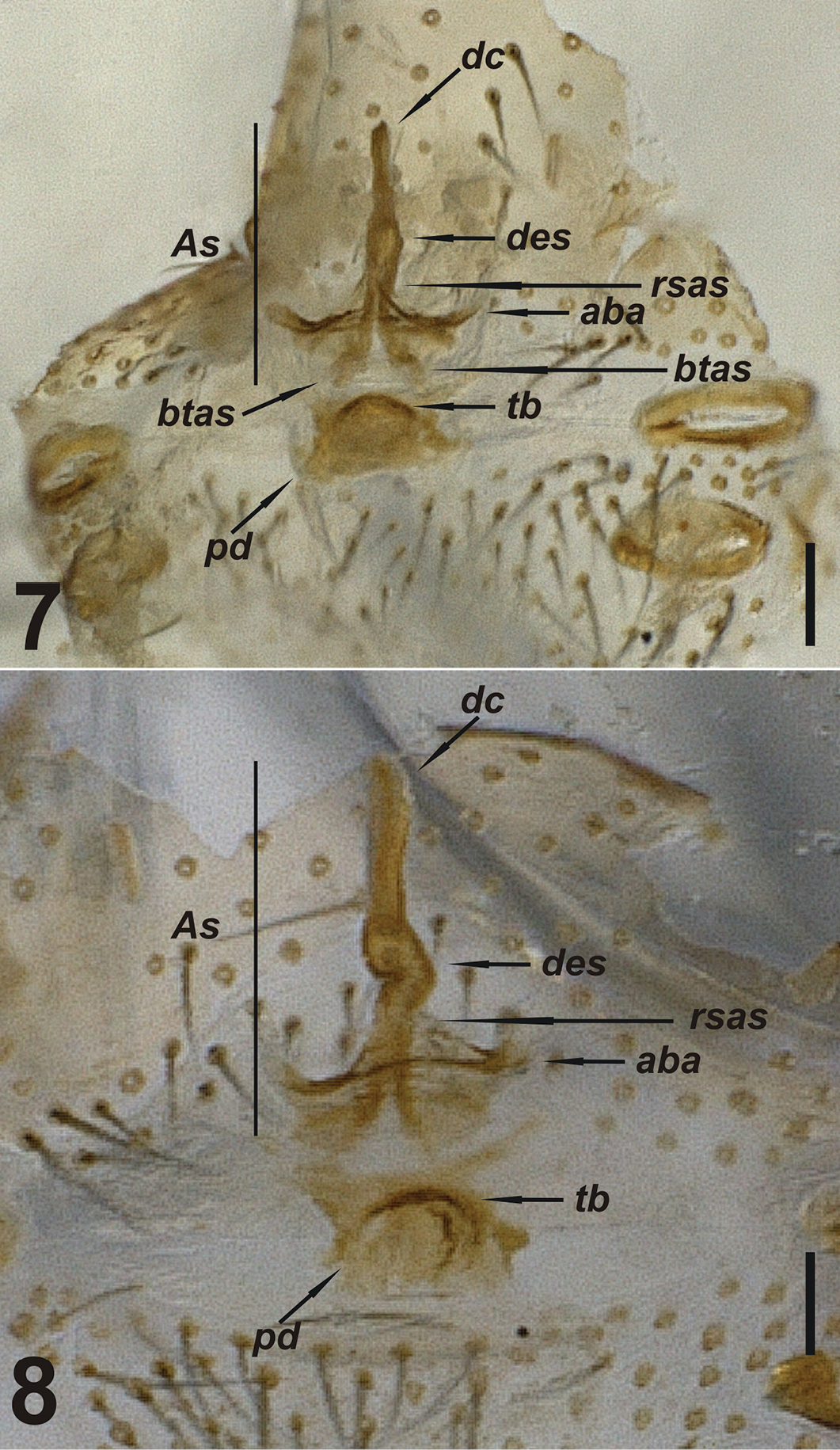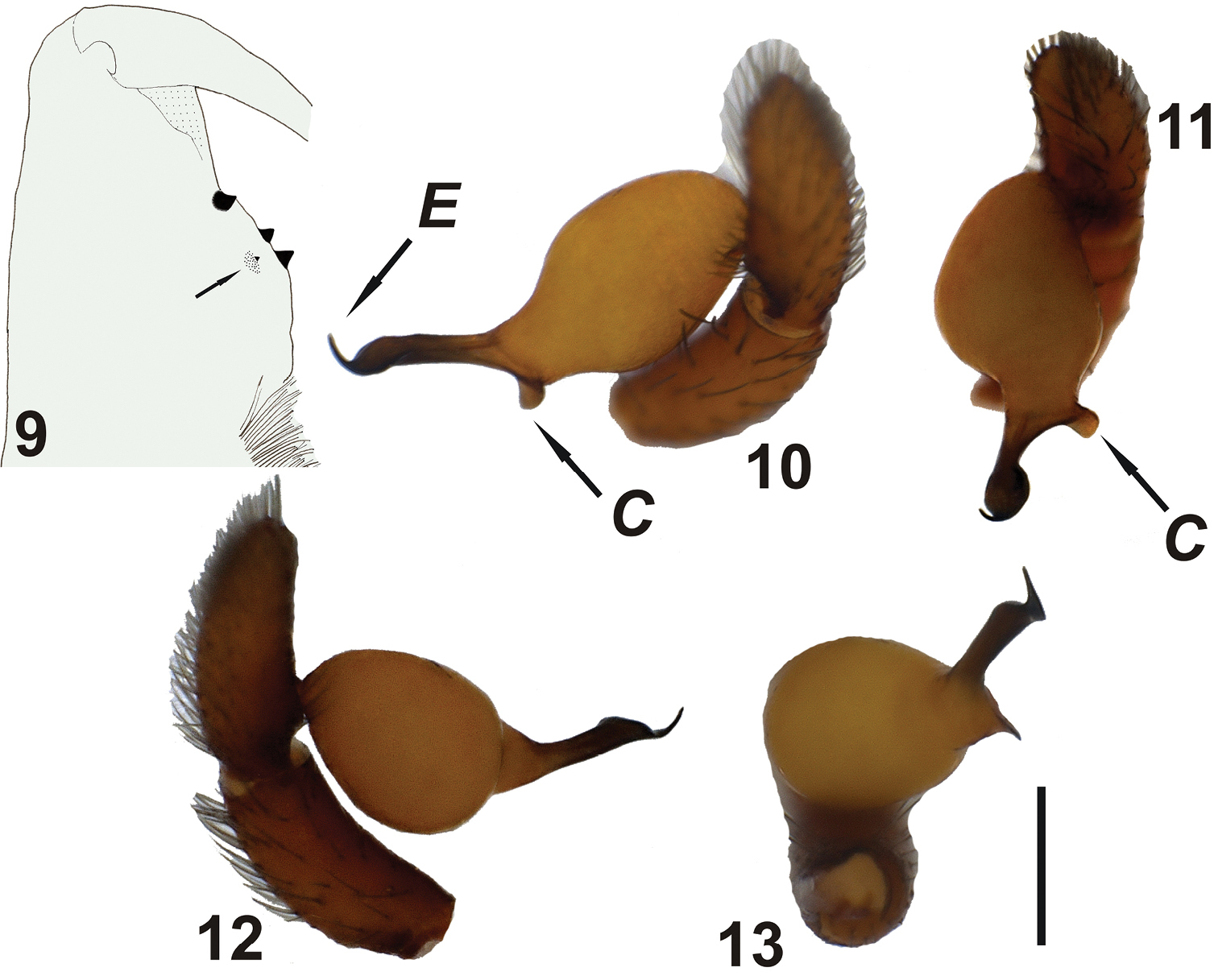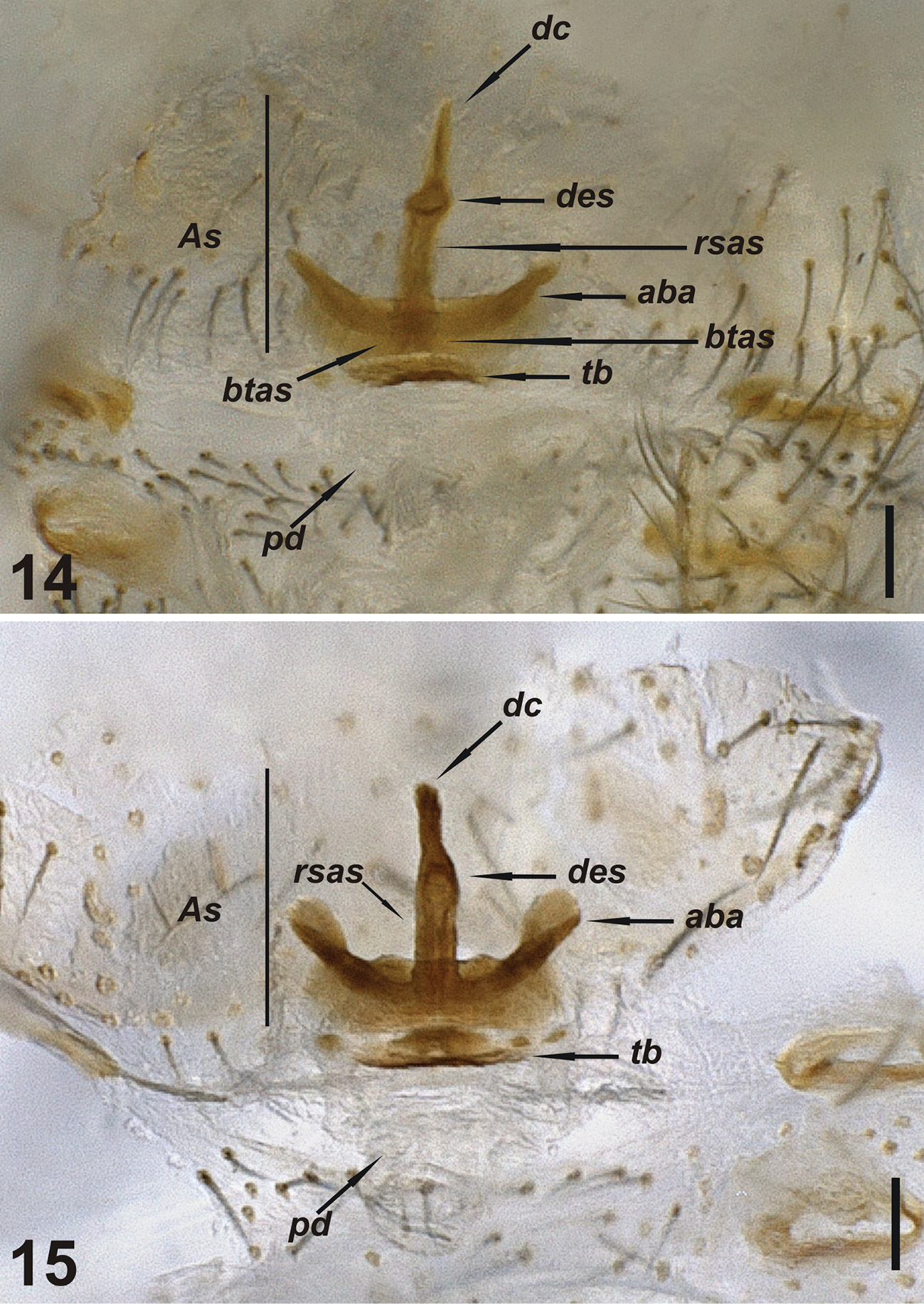






(C) 2011 Kadir Boğaç Kunt. This is an open access article distributed under the terms of the Creative Commons Attribution License, which permits unrestricted use, distribution, and reproduction in any medium, provided the original author and source are credited.
For reference, use of the paginated PDF or printed version of this article is recommended.
Two new species, Harpactea arnedoi sp. n. and Harpactea kencei sp. n., are described on the basis of both sexes from the eastern Mediterranean and Aegean regions of Turkey. Harpactea kencei sp. n. can be easily distinguished from all other Turkish and European representatives of the genus by the structure of the flattened, massive embolus on the male copulatory organ. Although resembling Stalagtia in palpal morphology, we describe one of the new species as Harpactea arnedoi sp. n. For both Turkish species, detailed morphological descriptions and diagnoses are presented together with figures of the copulatory organs.
Dysderidae, Harpacteinae, Eastern Mediterranean, Aegean
The first records of the genus Harpactea from Turkey were Harpactea babori from İstanbul Province and Harpactea sturanyi from Konya Province (
During our surveys of the Turkish spider fauna, we have encountered two new species of Harpactea from the eastern Mediterranean and Aegeanregions. The purpose of this study is to describe and diagnose these two new species on the basis of both sexes.
Materials and methodsSpecimens were collected by means of pitfall traps, sifter and hand collecting from two different provinces of Turkey (Fig. 1). Digital images of the pedipalps and vulvae were taken with a Leica DFC295 digital camera attached to a Leica S8AP0 stereomicroscope, with 5–15 photographs taken in different focal planes and combined using image stacking software. Photographic images were edited using PHOTOSHOP CS2 and COREL-DRAW X3 was used to create the plates. All measurements are in mm. Terminology for the body measurements and copulatory organs follows
Type localities of the new species. ★ Harpactea arnedoisp. n. ■ Harpactea kencei sp. n.
The following abbreviations are used in the text and figures: Carapace and abdomen: AL, abdominal length; CL, carapace length; CWmax, maximum carapace width; CWmin, minimum carapace width. Eyes: AME, anterior median eyes; PLE, posterior lateral eyes; PME, posterior median eyes; AMEd, diameter of anterior median eyes; PLEd, diameter of posterior lateral eyes; PMEd, diameter of posterior median eyes. Chelicera: ChF, length of cheliceral fang; ChG, length of cheliceral groove; ChL, total length of chelicera (lateral external view). Legs: Ta, tarsus; Me, metatarsus, Ti, tibia; Pa, patella; Fe, femur; Tr, trochanter; C, coxa; D, dorsal; Pl, prolateral; Rl, retrolateral; V, ventral. Male bulb: AA, accessory apophysis; Co, conductor; E, embolus. Vulva: aba, anterior basal arc; As, anterior spermatheca; btas, basal transverse part of the anterior spermatheca; dc, distal crest; des, distal expansion of the spermatheca; pd, posterior diverticulum; rsas, rod-shaped part of the anterior spermatheca; tb, transverse bar. Depository: AUZM, Anadolu University, Zoology Museum, Eskişehir, Turkey; cKBK, Personal collection of Kadir Boğaç Kunt, Ankara, Turkey; SMF, Senckenberg Museum, Frankfurt am Main, Germany.
TaxonomyFamily Dysderidae C. L. Koch, 1837
Genus Harpactea Bristowe, 1939
urn:lsid:zoobank.org:act:8BC9D2B7-4E3D-4A17-8017-6DAB08F82D8F
http://species-id.net/wiki/Harpactea_arnedoi
Figs 2–8Holotype ♂ (AUZM), Turkey, Gaziantep Province, Kuşçubeli Pass [37°6'50.20"N; 36°36'34.20"E], 13.XI.2010, under leaf litter, leg. E.A.Yağmur. Paratypes 1 ♀, 1 ♂ (AUZM); 2 ♀♀, 2 ♂♂, 9 juveniles (cKBK & SMF), same data as holotype.
The new species is dedicated to the Spanish arachnologist, Dr. Miquel Arnedo (Barcelona University, Barcelona, Spain), who has made important contributions to the taxonomy of the family Dysderidae.
Harpactea arnedoi sp. n. differs from all other Harpactea species in the structure of the copulatory organs. However, the general morphology of the male palp resembles that of Harpactea zoiai Gasparo, 1999 known from Greece (see
Harpactea arnedoi sp. n. 2 Cheliceral teeth 3 left palp, retrolateral view 4 ditto, nearly anterior view 5 ditto, nearly retrolateral view 6 ditto, distal view. Scale line: 0.5 mm.
Vulva of Harpactea arnedoi sp. n. 7 dorsal view 8 ventral view. Scale lines: 0.1 mm.
While describing Harpactea arnedoi sp. n., it was difficult to decide whether it would be best assigned to Harpactea or to Stalagtia. By the characteristic structure of the male copulatory organ (globular tegulum, long embolus, poorly developed conductor), the new species is similar to members of Stalagtia. However, the male palp possesses a poorly developed conductor (Fig. 4), and the female copulatory organs are similar to those of Harpactea species in having a short posterior diverticulum and anterior spermathecae. Thus, we feel the new species is correctly placed in Harpactea. Further evidence in support of this generic placement is the absence of ventral spines on the anterior tibiae and metatarsi in the new species, particularly as
Measurements: [Holotype ♂ / Paratype ♀]: AL 2.26 / 2.50; CL 1.75 / 1.73; CWmax 1.45 / 1.35; CWmin 0.63 / 0.65; AMEd 0.10 / 0.11; PLEd 0.09 / 0.09; PMEd 0.08 / 0.08; ChF 0.37 / 0.38; ChG 0.18 / 0.19; ChL 0.62 / 0.64 mm. Leg measurements are given in Table 1.
Leg measurements of Harpactea arnedoi sp. n.
| (Holotype ♂ / Paratype ♀) | Fe | Pa | Ti | Me | Ta |
| Leg I | 1.42 / 1.23 | 0.80 / 0.73 | 1.15 / 0.98 | 1.05 / 0.78 | 0.38 / 0.32 |
| Leg II | 1.10 / 1.17 | 0.80 / 0.75 | 1.12 / 0.93 | 1.05 / 0.85 | 0.37 / 0.31 |
| Leg III | 1.05 / 1.00 | 0.55 / 0.55 | 0.83 / 0.63 | 1.02 / 0.95 | 0.37 / 0.32 |
| Leg IV | 1.63 / 1.50 | 0.83 / 0.78 | 1.40 / 1.25 | 1.50 / 1.35 | 0.40 / 0.33 |
MALE: Small sized spider. Carapace greenish - light brown, with smooth surface and distinct fovea. AME, PLE and PME closely grouped; AME separated. Sternum, labium, gnathocoxae and chelicerae light brown. Sternum dark brown laterally, with thin, long hair near margins. Cheliceral groove with four teeth: retromargin with two tiny teeth; promargin with two strong teeth, largest tooth closest to base of the cheliceral groove (Fig. 2). Top of the labium and gnathocoxae with short, strong hair, sparsely distributed. Abdomen greyish-light brown, with short, thin blackish hair over the entire surface. Legs yellowish-light brown with sparse blackish setae. Ventral surface of coxae with long, thin, black sparse hair. Leg IV > Leg I > Leg II > Leg III. Tarsi with three claws. Tarsi III and IV with fine scopulae. Legs III and IV with fine metatarsal scopulae covering slightly less than the distal half of the segment (ventral surface only). Prolateral part of coxae III and IV with 1 spine. Dorsal parts of femora, tibiae and metatarsi with spines. Number of spines can vary among individuals. Detailed leg spination of Harpactea arnedoisp. n. is given in Table 2.
Leg spination of Harpactea arnedoisp. n.
| ♂ (Holotype) | Leg I | Leg II | Leg III | Leg IV |
| C | 0 | 0 | 1 Pl | 1 Pl |
| Fe | 2 Pl | 1-2 Pl | 1, 1 Pl 1, 1, 1 D | 2 Pl 1 D |
| Pa | 0 | 0 | 1 Rl | 0 |
| Ti | 0 | 0 | 1, 1 Pl 2, 1, 1 Rl 1, 1, 2 V | 1, 1 Pl 1 D 2, 1, 1 Rl 1, 1, 2 V |
| Me | 0 | 0 | 1, 1 Pl 1, 1, 1 Rl 1, 1, 2 V | 1, 1, 1 Pl 1, 1, 1 D 4 Rl 1, 1, 2 V |
| ♀ (Paratype) | ||||
| C | 0 | 0 | 1 Pl | 1 Pl |
| Fe | 2 Pl | 1 Pl | 1 Pl 1, 1 D | 2 Pl 2 D |
| Pa | 0 | 0 | 1 Rl | 0 |
| Ti | 0 | 0 | 1, 1 Pl 2, 1, 1 Rl 1, 1, 2 V | 1, 1, 1 Pl 1 D 2, 1, 1 Rl 1, 1, 2 V |
| Me | 0 | 0 | 1, 1, 1 Pl 1, 1 Rl 1, 1, 2 V | 1, 1, 2 Pl 1, 1 D 4 Rl 1, 1, 2 V |
Palpal tarsus of the male covered with thin and elongated setae. Tegulum yellow, lighter than the legs. Bulb almost spherical. The anteroventral region of the bulb has a chitinized edge. Between bulb and distal appendages there is a neck-shaped transition region (Figs 3–5). This region is lightly chitinized and dusky in patches. From the base of the embolus, conductor and accessory apophysis have dark brown tips. Embolus is slender and cylindrical up to its hook-like tip and it is not so heavily sclerotized. At the periphery it is membranous and projects downwards, parallel to the palpal tibia. Conductor and accessory apophysis are developed at the end of the neck-shaped transition region, on the opposite tips of an ear-shaped structure. Both are triangular in shape, whereas the accessory apophysis is longer and jagged (Fig. 6). The relative positions of the distal appendages are most easily seen at a 90 degree angle in ventral view. Embolus separated from conductor and accessory apophysis by a broad base, at first it follows the course of the conductor, but later bends with a sharp curve and accompanies the accessory apophysis.
FEMALE: No differences found between male and female, in terms of body colour and morphology. Vulva sclerotized almost uniformly. Distal crest long and butt-ended at the tip. Distal expansion of spermatheca convoluted. Rod-shaped part of the anterior spermatheca short and cylindrical. Basal transverse part of the anterior spermatheca separates from rod-shaped part laterally at an acute angle and forms a triangular shape. Anterior basal arc lies linearly through the centre and periphery, but widens at the edges. Transverse bar short and crescent-shaped with tips turned downwards. Posterior diverticulum shaped as a membranous sac and is sclerotized at the periphery (Figs 7, 8).
Specimens were collected in Kuşçubeli Pass, located in the Amanos Mountains, from habitats covered by Turkish Pine (Pinus brutia) and scrub type oak forests (Quercus infectoria). A variety of herbaceous plants and low shrubs such as Ruscus aculeatus are also widely represented in those forests. Sampling was done by sifting leaf litter during the early winter.
Harpactea arnedoisp. n. is known from thetype locality only.
urn:lsid:zoobank.org:act:557FE296-4BF3-4E21-A8D6-4750C38795E6
http://species-id.net/wiki/Harpactea_kencei
Figs 9–15Holotype ♂ (AUZM), Turkey, Muğla Province, Milas District, Kıyıkışlacık Village [37°16'38.80"N; 27°33'47.97"E], 13.XI.2010, under stones, leg. M.Elverici. Paratypes 1 ♀ (AUZM), 1 ♀ 5 ♂♂ (cKBK & SMF), same data as holotype.
The new species is named in honor of the well-known Turkish biologist Prof. Dr. Aykut Kence (Middle East Technical University, Ankara, Turkey) for his important contributions to Turkish biology.
Harpactea kencei sp. n. can be easily distinguished from all other Turkish Harpactea by the unique structure of the male palp and broad, grooved sides, crescent like anterior basal arc-shaped structure of the female vulva. In general appearance the embolus is well sclerotized, thorn-like and with a hook-shaped tip. Towards the tip, the embolus flattens like a spoon and ends with a thorn-like tip inflecting upon itself. On the embolar base there is a small ear-shaped conductor relatively well sclerotized at its peripheries. This is attached to the embolus at an angle of 90 degrees. Unique embolus (not a simple thornlike structure) and the presence of the conductor differentiate Harpactea kencei sp. n. from Harpactea diraoi, Harpactea isaurica, Harpactea sanctaeinsulae and any other similar Turkish species, which all have simple spiniform embolus structures (see
Measurements: [Holotype ♂ / Paratype ♀]: AL 2.13 / 2.25; CL 1.63 / 1.96; CWmax 1.35 / 1.53; CWmin 0.63 / 0.75; AMEd 0.07 / 0.08; PLEd 0.05 / 0.07; PMEd 0.05 / 0.06; ChF 0.34 / 0.37; ChG 0.21 / 0.27; ChL 0.64 / 0.71 mm. Leg measurements are given in Table 3.
MALE: Small to medium sized spider. Carapace reddish dark brown, with smooth surface and distinct fovea. AME, PLE and PME closely grouped; AME separated. Difference between width of eyes region and thoracic region of carapace remarkable. Sternum, labium, gnathocoxae and chelicerae reddish-brown. Sternum with long, thin hair near the margin, while centrally smooth and shiny. Cheliceral groove with four teeth: retromargin bears a tiny tooth at the base of the groove and a strong tooth at the top; promargin with two strong teeth of almost equal sizes (Fig. 9). Labium with short, strong hair, sparsely distributed along the surface; hair cover denser at the top. Gnathocoxae also with moderately strong hair, denser and slightly longer at the margins. Abdomen yellowish-light brown, with short, thin blackish hair over the entire surface. Legs yellowish-light brown with sparse blackish setae. Anterior legs slightly darker than posterior legs. Leg IV > Leg I > Leg II > Leg III. Tarsi with three claws. Tarsi III and IV with fine scopulae. Legs III and IV with fine metatarsal scopulae covering slightly less than the distal half of the segment (ventral surface only). Prolateral part of coxae III and IV with 0-5 spines. Detailed leg spination of Harpactea kencei sp. n. is given in Table 4.
Leg measurements of Harpactea kencei sp. n.
| (Holotype ♂ / Paratype ♀) | Fe | Pa | Ti | Me | Ta |
| Leg I | 1.57 / 1.61 | 0.95 / 0.96 | 1.28 / 1.29 | 1.25 / 1.27 | 0.48 / 0.48 |
| Leg II | 1.48 / 1.50 | 0.80 / 0.82 | 1.23 / 1.25 | 1.20 / 1.22 | 0.40 / 0.40 |
| Leg III | 1.13 / 1.17 | 0.56 / 0.63 | 0.80 / 0.88 | 0.90 / 1.13 | 0.40 / 0.40 |
| Leg IV | 1.62 / 1.63 | 0.82 / 0.87 | 1.45 / 1.57 | 1.52 / 1.75 | 0.51 / 0.53 |
Leg spination of Harpactea kencei sp. n.
| ♂ (Holotype) | Leg I | Leg II | Leg III | Leg IV |
| C | 0 | 0 | 1Pl | 5 Pl |
| Fe | 2, 1 Pl | 1, 1, 1 Pl | 1, 1 D 1, 1 Rl | 3, 1, 1 D |
| Pa | 0 | 0 | 1 Rl | 0 |
| Ti | 0 | 0 | 1, 2 Pl 2, 1, 2 Rl 1, 1, 2 V | 2, 1, 1 Pl 2, 1, 1 Rl l 1, 1, 2 V |
| Me | 0 | 0 | 1, 1, 1 Pl 5 Rl 2 V | 1, 1, 1 Pl 1, 1, 1 Rl 3, 2 V |
| ♀ (Paratype) | ||||
| C | 0 | 0 | 0 | 1 Pl |
| Fe | 2 Pl | 2 Pl | 1, 1 D 1, 1 Rl | 2, 1, 1 D |
| Pa | 0 | 0 | 1 Rl | 0 |
| Ti | 0 | 0 | 1, 1 Pl 2, 1, 1 Rl 1, 1, 2 V | 2, 1, 1 Pl 2, 1, 1 Rl 1, 1, 2 V |
| Me | 0 | 0 | 1, 1 Pl 6 Rl 2, 2 V | 1, 1, 1 Pl 1, 1, 1 Rl 2, 1, 2 V |
Tegulum yellowish brown, longer than wide, cylindrical. Embolar base broad, embolus and conductor reciprocally located at peripherals. Accessory apophysis absent. Embolus blackish brown, flattens like a spoon through the tip and ends with a thorn-like tip inflecting upon itself. Conductor small, flattened and ear-shaped, separated from embolus at the base.
FEMALE: No differences found between male and female, in terms of body colour and morphology. Distal crest of vulva short, with conical tip. Distal expansion of spermatheca spherical, with triangular shape. Basal transverse part of the anterior spermatheca short, linear and peripherally sclerotized. Rod-shaped part of the anterior spermatheca elongated. Anterior basal arc crescent-like and grooved. Tips membranous, in the shape of half of a heart. Transverse bar smooth, well sclerotized at the center. Posterior diverticulum membranous (Figs 14–15).
Harpactea kencei sp. n. 9 Cheliceral teeth 10 left palp, retrolateral view 11 ditto, nearly anterior view 12 ditto, prolateral view 13 ditto, distal view. Scale line: 0.5 mm.
Vulva of Harpactea kencei sp. n. 14 dorsal view 15 ventral view. Scale lines: 0.1 mm.
Specimens were collected in the course of field studies aiming to determine the spider fauna of olive groves found in Kıyıkışlacık Village. The area was surveyed periodically over one year using pitfall traps, sweep nets, active searching at ground level and under stones both during the day and at night, sifting tree litter and by shaking tree branches. The altitude of the study area varied from sea level up to 100 m at its maximum.
Individuals of the new species were found under stones and collected from pitfall traps in olive groves and shrub forest associations dominated by Quercus trees. The first adult specimen was collected in November and additional specimens were found during March and April. It is likely that this species is most active during the early spring.
Harpactea kencei sp. n. is known from thetype locality only.
According to the classification established by
1. Posterior diverticulum of the female vulva membranous in both species.
2. Embolus of Harpactea arnedoi sp. n. is spiniform, while it is massive-spiniform and flattened in Harpactea kencei sp. n.
3. Conductor massive in both species.
4. Patellae and coxae with spines in both species.
The genus Harpactea is represented in Turkey by 20 described species. Of these, Harpactea agnolettii, Harpactea colchidis, Harpactea galatica, Harpactea lazonum, Harpactea lyciae, Harpactea medeae, Herpactes pisidica, Harpactea sbordonii and Harpactea vignai were described on the basis of females only; while Harpactea christodeltshevi, Harpactea erseni and Harpactea korgei were described on the basis of males. Due to the inadequacy of the existing descriptions, and the unavailability of many of the type specimens for further investigations, it is currently not possible to draw accurate conclusions about the status of the genus Harpactea in Turkey. Nevertheless, the relevant literature shows that most of the recorded species belong in the species group rubicunda (D)andHarpactea species belonging to this group have often been described from Thrace, Aegean and the Mediterranean coast (see
With the descriptions of Harpactea arnedoi sp. n. and Harpactea kencei sp. n. presented herein, the total number of Harpactea species reported from Turkeyis now 22. With the exception of Harpactea babori, Harpactea mithridatis and Harpactea sturanyi, all other species are only known only from their type localities or proximate vicinities. Harpactea babori, with the type locality in Büyükada (Insel Prinkipo), has a distribution pattern ranging from Belgrad Forest (Silva Belgradensis) which is one of the last remaining relict forests in İstanbul, and lies along the Istranca Mountain range (both Bulgarian and Turkish sides). As the predominant harpacteid spider species of the Istranca Mountains, Harpactea babori has been recorded from Shumen Town in Bulgaria as the northernmost record and from Stara Planina as the westernmost record of its known distribution range. Harpactea mithridatis has been recorded from Ordu province (East Black Sea Region) in Turkey and from Adzharia region(Khulo) in SW Georgia; while Harpactea sturanyi, in addition to its type locality in Konya (Central Anatolia), has also been recorded from the Aegean coast of Turkey (Denizli, İzmir and Muğla provinces; senior author, pers. obs.) and from the Bulgarian side of the Istranca Mountain (see
This work was supported by the Research Foundation of Anadolu University (Project Number: 1001F31) and partly supported by the Bulgarian Ministry of Education and Science (project “Investigation of model epigeobiont and geobiont animal groups as a potential for long-term monitoring and conservation of the biodiversity in Strandja Mountain (Bulgaria and Turkey)” No: DVU01-116). We are very grateful to Dr. Fulvio Gasparo (Italy) for his valuable comments regarding the new species. We would like to thank Dr. Yuri Marusik (Russian Federation) for translations of Russian texts and our colleagues Dr. Sinan Anlaş (Turkey) and Mr. Mehmet Özkörük (Gaziantep, Turkey) for their important help during field trips. The English of the final draft was kindly checked by Dr. David Penney (United Kingdom).
